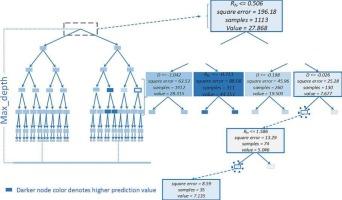Evaluation of the random forest regression machine learning technique as an alternative to ecoregional based regression taper modelling
IF 8.9
1区 农林科学
Q1 AGRICULTURE, MULTIDISCIPLINARY
引用次数: 0
Abstract
Ecologically oriented management plans are based upon accurate estimation of stand growth and yield under various climatic and growing environmental conditions. Furthermore, the precise calculation of the volume quantities of the wood classes that can be obtained from a tree is of great importance for the production of forest management plans and projections for the future of the forest products industry. Despite their limitations, stem taper regression models are one of the most widely used methods for estimating tree diameters along the bole and estimating the tree stem volume. In this study, the non-parametric ensemble algorithm RFr was evaluated as an alternative machine learning approach for ecoregion-based taper modelling. RFr models were developed to accurately estimate stem diameters along the tree bole for trees from three distinct ecoregions, yielding precise diameter predictions. A comparative analysis between the RFr models and traditional taper regression models demonstrated that both methods are capable of reliably predicting stem diameters and tree volumes. However, the non-parametric nature of the RFr modelling approach, which effectively reduces the variance of individual regression tree learners, allowed it to outperform the conventional taper regression. The RFr models produced more accurate predictions of both stem diameter and volume and exhibited high reliability in their prediction intervals, as confirmed by uncertainty assessments. Overall, the RFr approach showed superior performance on both training and testing datasets.

评价随机森林回归机器学习技术作为基于生态区域的回归锥度模型的替代方法
以生态为导向的管理计划是基于对不同气候和生长环境条件下林分生长和产量的准确估计。此外,精确计算从一棵树上可以获得的木材种类的体积数量对于森林管理计划的制定和对林产品工业未来的预测非常重要。尽管有其局限性,但茎杆锥度回归模型是估计沿孔采油树直径和估计采油树茎杆体积最广泛使用的方法之一。在这项研究中,非参数集成算法RFr被评估为基于生态区域的锥度建模的替代机器学习方法。开发了RFr模型,用于准确估计三个不同生态区树木沿树孔的茎直径,从而得出精确的直径预测。RFr模型与传统锥度回归模型的对比分析表明,两种方法都能够可靠地预测树干直径和树木体积。然而,RFr建模方法的非参数性质,有效地减少了个体回归树学习器的方差,使其优于传统的锥形回归。经不确定性评估证实,RFr模型对管柱直径和管柱体积的预测更为准确,预测区间的可靠性也较高。总的来说,RFr方法在训练和测试数据集上都表现出优异的性能。
本文章由计算机程序翻译,如有差异,请以英文原文为准。
求助全文
约1分钟内获得全文
求助全文
来源期刊

Computers and Electronics in Agriculture
工程技术-计算机:跨学科应用
CiteScore
15.30
自引率
14.50%
发文量
800
审稿时长
62 days
期刊介绍:
Computers and Electronics in Agriculture provides international coverage of advancements in computer hardware, software, electronic instrumentation, and control systems applied to agricultural challenges. Encompassing agronomy, horticulture, forestry, aquaculture, and animal farming, the journal publishes original papers, reviews, and applications notes. It explores the use of computers and electronics in plant or animal agricultural production, covering topics like agricultural soils, water, pests, controlled environments, and waste. The scope extends to on-farm post-harvest operations and relevant technologies, including artificial intelligence, sensors, machine vision, robotics, networking, and simulation modeling. Its companion journal, Smart Agricultural Technology, continues the focus on smart applications in production agriculture.
 求助内容:
求助内容: 应助结果提醒方式:
应助结果提醒方式:


